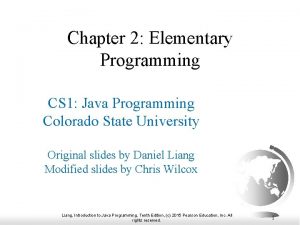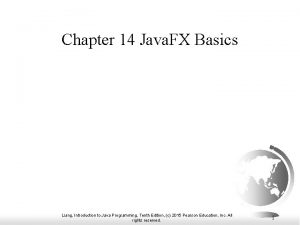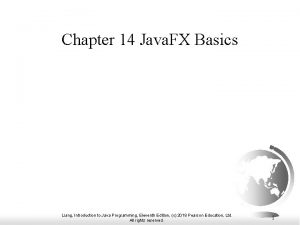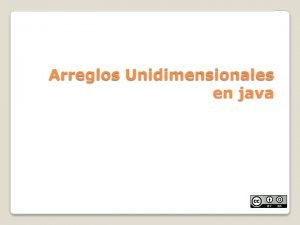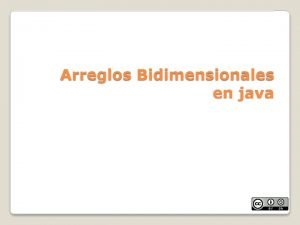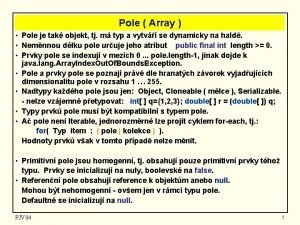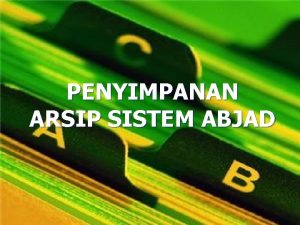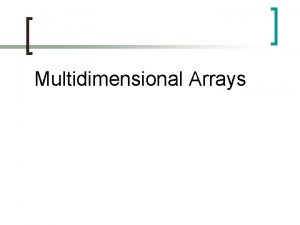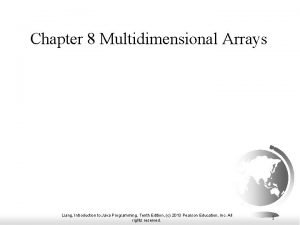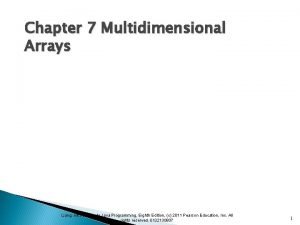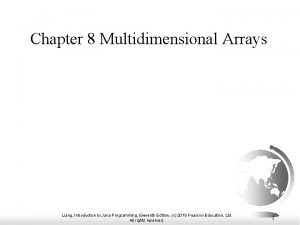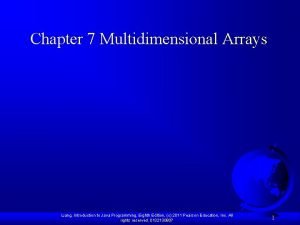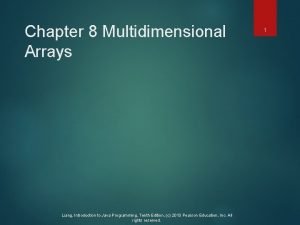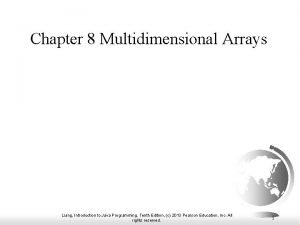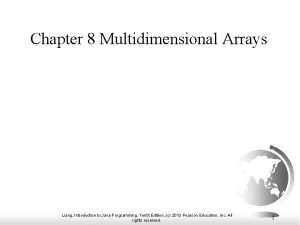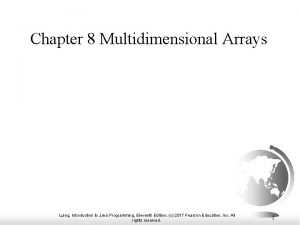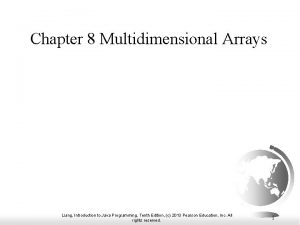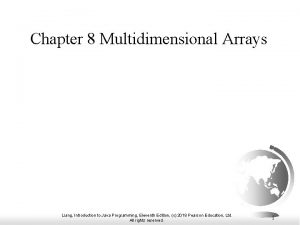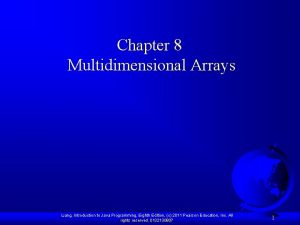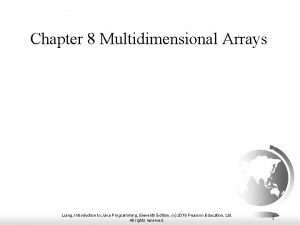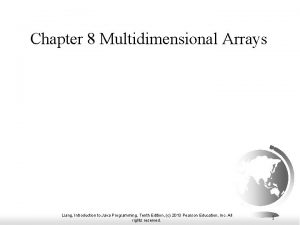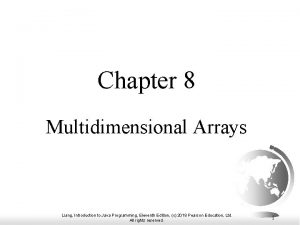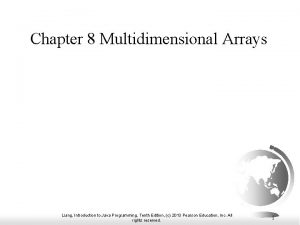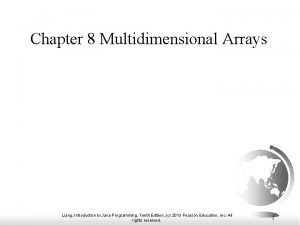Chapter 8 Multidimensional Arrays Liang Introduction to Java



![Declare/Create Two-dimensional Arrays // Declare array ref var data. Type[][] ref. Var; // Create Declare/Create Two-dimensional Arrays // Declare array ref var data. Type[][] ref. Var; // Create](https://slidetodoc.com/presentation_image_h/ae756108cda6ac83ac18985a33134c08/image-4.jpg)
![Declaring Variables of Twodimensional Arrays and Creating Two -dimensional Arrays int[][] matrix = new Declaring Variables of Twodimensional Arrays and Creating Two -dimensional Arrays int[][] matrix = new](https://slidetodoc.com/presentation_image_h/ae756108cda6ac83ac18985a33134c08/image-5.jpg)
![Two-dimensional Array Illustration matrix. length? 5 array. length? 4 matrix[0]. length? 5 array[0]. length? Two-dimensional Array Illustration matrix. length? 5 array. length? 4 matrix[0]. length? 5 array[0]. length?](https://slidetodoc.com/presentation_image_h/ae756108cda6ac83ac18985a33134c08/image-6.jpg)

![Lengths of Two-dimensional Arrays int[][] x = new int[3][4]; Liang, Introduction to Java Programming, Lengths of Two-dimensional Arrays int[][] x = new int[3][4]; Liang, Introduction to Java Programming,](https://slidetodoc.com/presentation_image_h/ae756108cda6ac83ac18985a33134c08/image-8.jpg)
![Lengths of Two-dimensional Arrays, cont. int[][] array = { {1, 2, 3}, {4, 5, Lengths of Two-dimensional Arrays, cont. int[][] array = { {1, 2, 3}, {4, 5,](https://slidetodoc.com/presentation_image_h/ae756108cda6ac83ac18985a33134c08/image-9.jpg)







![Summing elements by column for (int column = 0; column < matrix[0]. length; column++) Summing elements by column for (int column = 0; column < matrix[0]. length; column++)](https://slidetodoc.com/presentation_image_h/ae756108cda6ac83ac18985a33134c08/image-17.jpg)

- Slides: 18

Chapter 8 Multidimensional Arrays Liang, Introduction to Java Programming, Tenth Edition, (c) 2013 Pearson Education, Inc. All rights reserved. 1

Motivations Thus far, you have used one-dimensional arrays to model linear collections of elements. You can use a two-dimensional array to represent a matrix or a table. For example, the following table that describes the distances between the cities can be represented using a two-dimensional array. Liang, Introduction to Java Programming, Tenth Edition, (c) 2013 Pearson Education, Inc. All rights reserved. 2

Motivations Liang, Introduction to Java Programming, Tenth Edition, (c) 2013 Pearson Education, Inc. All rights reserved. 3
![DeclareCreate Twodimensional Arrays Declare array ref var data Type ref Var Create Declare/Create Two-dimensional Arrays // Declare array ref var data. Type[][] ref. Var; // Create](https://slidetodoc.com/presentation_image_h/ae756108cda6ac83ac18985a33134c08/image-4.jpg)
Declare/Create Two-dimensional Arrays // Declare array ref var data. Type[][] ref. Var; // Create array and assign its reference to variable ref. Var = new data. Type[10]; // Combine declaration and creation in one statement data. Type[][] ref. Var = new data. Type[10]; // Alternative syntax data. Type ref. Var[][] = new data. Type[10]; Liang, Introduction to Java Programming, Tenth Edition, (c) 2013 Pearson Education, Inc. All rights reserved. 4
![Declaring Variables of Twodimensional Arrays and Creating Two dimensional Arrays int matrix new Declaring Variables of Twodimensional Arrays and Creating Two -dimensional Arrays int[][] matrix = new](https://slidetodoc.com/presentation_image_h/ae756108cda6ac83ac18985a33134c08/image-5.jpg)
Declaring Variables of Twodimensional Arrays and Creating Two -dimensional Arrays int[][] matrix = new int[10]; or int matrix[][] = new int[10]; matrix[0][0] = 3; for (int i = 0; i < matrix. length; i++) for (int j = 0; j < matrix[i]. length; j++) matrix[i][j] = (int)(Math. random() * 1000); double[][] x; Liang, Introduction to Java Programming, Tenth Edition, (c) 2013 Pearson Education, Inc. All rights reserved. 5
![Twodimensional Array Illustration matrix length 5 array length 4 matrix0 length 5 array0 length Two-dimensional Array Illustration matrix. length? 5 array. length? 4 matrix[0]. length? 5 array[0]. length?](https://slidetodoc.com/presentation_image_h/ae756108cda6ac83ac18985a33134c08/image-6.jpg)
Two-dimensional Array Illustration matrix. length? 5 array. length? 4 matrix[0]. length? 5 array[0]. length? 3 Liang, Introduction to Java Programming, Tenth Edition, (c) 2013 Pearson Education, Inc. All rights reserved. 6

Declaring, Creating, and Initializing Using Shorthand Notations You can also use an array initializer to declare, create and initialize a two-dimensional array. For example, int[][] array = { {1, 2, 3}, {4, 5, 6}, {7, 8, 9}, {10, 11, 12} }; Same as int[][] array = new int[4][3]; array[0][0] = 1; array[0][1] = 2; array[0][2] = 3; array[1][0] = 4; array[1][1] = 5; array[1][2] = 6; array[2][0] = 7; array[2][1] = 8; array[2][2] = 9; array[3][0] = 10; array[3][1] = 11; array[3][2] = 12; Liang, Introduction to Java Programming, Tenth Edition, (c) 2013 Pearson Education, Inc. All rights reserved. 7
![Lengths of Twodimensional Arrays int x new int34 Liang Introduction to Java Programming Lengths of Two-dimensional Arrays int[][] x = new int[3][4]; Liang, Introduction to Java Programming,](https://slidetodoc.com/presentation_image_h/ae756108cda6ac83ac18985a33134c08/image-8.jpg)
Lengths of Two-dimensional Arrays int[][] x = new int[3][4]; Liang, Introduction to Java Programming, Tenth Edition, (c) 2013 Pearson Education, Inc. All rights reserved. 8
![Lengths of Twodimensional Arrays cont int array 1 2 3 4 5 Lengths of Two-dimensional Arrays, cont. int[][] array = { {1, 2, 3}, {4, 5,](https://slidetodoc.com/presentation_image_h/ae756108cda6ac83ac18985a33134c08/image-9.jpg)
Lengths of Two-dimensional Arrays, cont. int[][] array = { {1, 2, 3}, {4, 5, 6}, {7, 8, 9}, {10, 11, 12} }; array. length array[0]. length array[1]. length array[2]. length array[3]. length array[4]. length Array. Index. Out. Of. Bounds. Exception Liang, Introduction to Java Programming, Tenth Edition, (c) 2013 Pearson Education, Inc. All rights reserved. 9

Ragged Arrays Each row in a two-dimensional array is itself an array. So, the rows can have different lengths. Such an array is known as a ragged array. For example, int[][] matrix = { {1, 2, 3, 4, 5}, matrix. length is 5 matrix[0]. length is 5 {2, 3, 4, 5}, matrix[1]. length is 4 {3, 4, 5}, matrix[2]. length is 3 {4, 5}, matrix[3]. length is 2 matrix[4]. length is 1 {5} }; Liang, Introduction to Java Programming, Tenth Edition, (c) 2013 Pearson Education, Inc. All rights reserved. 10

Ragged Arrays, cont. Liang, Introduction to Java Programming, Tenth Edition, (c) 2013 Pearson Education, Inc. All rights reserved. 11

Processing Two-Dimensional Arrays See the examples in the text. 1. (Initializing arrays with input values) 2. (Printing arrays) 3. (Summing all elements) 4. (Summing all elements by column) 5. (Which row has the largest sum) 6. (Finding the smallest index of the largest element) 7. (Random shuffling) Liang, Introduction to Java Programming, Tenth Edition, (c) 2013 Pearson Education, Inc. All rights reserved. 12

Initializing arrays with input values java. util. Scanner input = new Scanner(System. in); System. out. println("Enter " + matrix. length + " rows and " + matrix[0]. length + " columns: "); for (int row = 0; row < matrix. length; row++) { for (int column = 0; column < matrix[row]. length; column++) { matrix[row][column] = input. next. Int(); } } Liang, Introduction to Java Programming, Tenth Edition, (c) 2013 Pearson Education, Inc. All rights reserved. 13

Initializing arrays with random values for (int row = 0; row < matrix. length; row++) { for (int column = 0; column < matrix[row]. length; column++) { matrix[row][column] = (int)(Math. random() * 100); } } Liang, Introduction to Java Programming, Tenth Edition, (c) 2013 Pearson Education, Inc. All rights reserved. 14

Printing arrays for (int row = 0; row < matrix. length; row++) { for (int column = 0; column < matrix[row]. length; column++) { System. out. print(matrix[row][column] + " "); } System. out. println(); } Liang, Introduction to Java Programming, Tenth Edition, (c) 2013 Pearson Education, Inc. All rights reserved. 15

Summing all elements int total = 0; for (int row = 0; row < matrix. length; row++) { for (int column = 0; column < matrix[row]. length; column++) { total += matrix[row][column]; } } Liang, Introduction to Java Programming, Tenth Edition, (c) 2013 Pearson Education, Inc. All rights reserved. 16
![Summing elements by column for int column 0 column matrix0 length column Summing elements by column for (int column = 0; column < matrix[0]. length; column++)](https://slidetodoc.com/presentation_image_h/ae756108cda6ac83ac18985a33134c08/image-17.jpg)
Summing elements by column for (int column = 0; column < matrix[0]. length; column++) { int total = 0; for (int row = 0; row < matrix. length; row++) total += matrix[row][column]; System. out. println("Sum for column " + column + " is " + total); } Liang, Introduction to Java Programming, Tenth Edition, (c) 2013 Pearson Education, Inc. All rights reserved. 17

Pass. Two. Dimensional. Array. java F Pages 295 -6 Listing 8. 1 Liang, Introduction to Java Programming, Tenth Edition, (c) 2013 Pearson Education, Inc. All rights reserved. 18
 Daniel liang introduction to java programming
Daniel liang introduction to java programming Liang fontdemo.java
Liang fontdemo.java Liang fontdemo.java
Liang fontdemo.java Parallel arrays examples
Parallel arrays examples Vectores unidimensionales ejemplos
Vectores unidimensionales ejemplos Arreglos bidimensionales java
Arreglos bidimensionales java List index out of bounds (0)
List index out of bounds (0) Richard seow yung liang
Richard seow yung liang Zhuo shi wo li liang
Zhuo shi wo li liang Zhong han liang
Zhong han liang Yuanxing liang
Yuanxing liang Amber liang
Amber liang The liang gie diindeks menjadi ....
The liang gie diindeks menjadi .... Zachary hensley
Zachary hensley David teo choon liang
David teo choon liang How was ma liang like
How was ma liang like Zong-liang yang
Zong-liang yang Liang jianhui
Liang jianhui Zhang liang game
Zhang liang game
